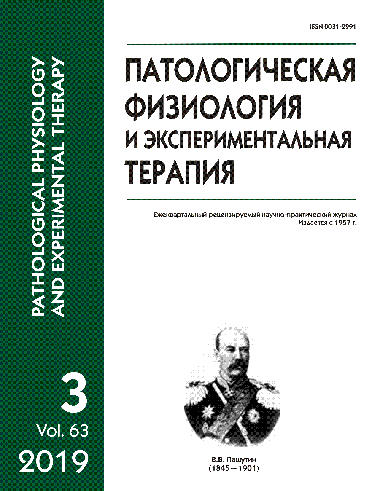The role of lymphoid and stem cell total rnas in correсtion of blood glucose level in experimental diabetes mellitus
Abstract
Aim. To study the effect of total RNA from lymphoid cells on blood glucose in experimental alloxan diabetes mellitus (DM). Methods. The study was conducted on 68 white mongrel rats of both sexes weighing 180-220 g. Alloxan DM was modeled with full Freund’s adjuvant (0.5 ml/rat). After 24 h of fasting with free access to water, a single dose of alloxan trihydrate (La Chemas, Czeck Republic) was injected subcutaneously (200 mg/kg as a 4% solution in saline). All rats received basis insulin therapy starting from day 3 of the alloxan injection to prevent fatal ketoacidosis. Eight types of total RNA were used: from splenic lymphoid cells, bone marrow, and caudal part of the pancreas of intact rats; from splenic lymphoid cells of rats after blood withdrawal (2% of body weight 17 h prior to RNA isolation) (RNA after induction of increased morphogenetic activity); from splenic and thymic lymphoid cells of rats after blood withdrawal (2% of body weight 96 h prior to RNA isolation) (RNAs with high morphogenesis-inhibiting activity); and from peripheral blood lymphocytes and umbilical cord stromal stem cells of a healthy human. Results. The study showed a possibility for functional recovery of the insular apparatus and stable normalization of blood glucose level in rats with experimental alloxan DM, a model of clinical type 1 DM. Allogenic and xenogeneic total RNAs isolated from rat lymphoid organs, peripheral blood lymphocytes, and mesenchymal stromal cells of human umbilical cord were able to correct the blood glucose level in rats. Total RNAs isolated from different lymphoid organs and stem cells differently contributed to normalization of blood glucose in rats. These total RNAs were shown to influence different target tissues during restoration of the insular apparatus function. Conclusion. The study showed a principle possibility of effective therapy for types 1 and 2 DM and demonstrated the efficacy of non-invasive intranasal administration of allogenic and xenogeneic total RNAs from lymphoid and stem cells. These results indicated a need for developing a more relevant experimental model and offered a promising outlook for individualized treatment of this disease with due account of its peculiar features in each specific case. The study was conducted as a part of the Program for Basic Research of State Academies of Science in 2013-2020 on Development of Cell Models for Molecular Processes in Organs and Tissue (V.N. Orekhovich Research Institute of Biomedical Chemistry) and the complex Research Work #01201354257 on Regulation of Hemopoietic and Nonhemopoietic Functions of Bone Marrow Cells in Experiment and Clinic (Sounth Ural State Medical University).






